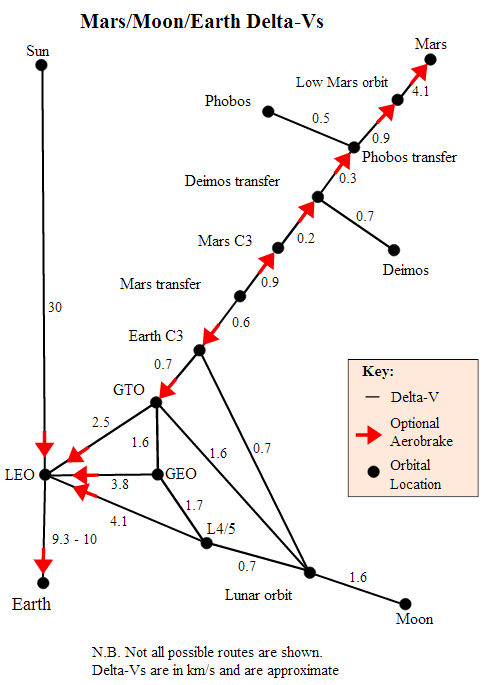The Delta-V Pointcrawl
I prefer running space travel as a pointcrawl. Space is quite empty and I would rather skip the travel part. I was inspired by the concept of delta-v in space flight as an alternative resource to manage. It combines both fuel, engine output and mass, which makes it a sort of maneuverability stat.
- A small surface to earth dropship might have a delta-v of 20km/s. This allows it to quickly land and take off with minimal time in range of enemy fire.
- A giant interstellar cruiser may have a delta-v of only 2km/s. It does not need more to travel between planetary orbits.
This aspect of space craft can’t be described by using only fuel capacity or only engine output.
What Is Delta-V Really?
Delta-V is simply change in velocity of a spacecraft when it performs a manoeuvre. It is a measure of the impulse per unit of mass, so the heavier the spacecraft, the less delta-v it will have. Less delta-v means the spacecraft cannot as easily go up to speed or slow down. In space this measure is crucial as precisely the change in speed determines a spacecrafts ability to reach targets.
A spacecraft that is super fast or has great fuel capacity wouldnt be able to get anywhere if it does not have enough impulse (generally speaking the “strength” of the engines) to slow down into orbit when it arrives. Modern spaceflight techniques favour slow and light spacecraft because they require less energy to achieve needed delta-v.
Plotting an Interplanetary Path
Let’s look at a real life delta-v graph to get more familiar with how it works.

To the left you can see a delta-v map of the Sun-Earth-Mars system. The numbers next to the path show how much delta-v is needed to perform the necessary manoeuvre. So a spacecraft with 17km/s of delta-v can make one trip to the moon (adding up all the values). For context, that is the total delta-v of Saturn V, the most powerful rocket launched by humans so far.
The greatest delta-v is required to enter and exit the gravity wells of planets. That delta-v is called escape velocity and is proportional to a planets gravity. A trip from the Moon to Phobos for instance will take much much less delta-v than Earth to Mars (even though the distance is basically the same on cosmic scales).
Because of this, moons are trade hubs, ports and population centres. I agree with Throne of Salt’s idea that terrestrial planets would be more isolated and harder to access for the average person in the setting.
You may also notice that the graph has points which are neither moons nor planets. Those are places in space where your spacecraft would be stable for a while, like orbits and Lagrange points. In a sci-fi setting those are perfect for space stations.
And this graph is only for a system of two planets and a star. When you are making one for your own setting, it will likely be more like a series of webs, connected by interstellar space. Asteroid belts or large moon systems (like Jupiter’s) would be a great locations for pointcrawls for their interconnectedness and low delta-v requirements.
Remember that these delta-v values are given for the perfect transfer windows. For the Moon it occurs once every few weeks, for Mars it’s every few years. If you want to make your travel system a bit more complex, you could adjust the delta-v values every few sessions. Making locations previously unavailable easier to access, and vice versa.
Another adjustment you can make is for the player’s cargo. For example reduce delta-v by 1 for every large piece of cargo carried on the ship. This way players will have to choose carefully what to carry, or what moons can they use to “hop” to their destination.
Organising Transport
So how might a transport network work (hehe) with delta-v in mind?
- In a more settled part of space I imagine commercial spacelanes, where ticket prices are tied to delta-v you want to travel. So the higher the delta-v needed to reach your destination, the higher the cost. To gamify this even further 1 currency might equal 1 delta-v. Then you could have cool currency symbols like 1Δ.
- In the outer rim, or if the players have their personal spacecraft, their travel options will depend greatly on the delta-v they have available. Modifying the spacecraft, like improving engines or reducing hull plating will increase those options, but that comes with its own trade offs. The players might have to get creative with how they can push just a little more delta-v from their craft (for example using wings).
- High traffic areas that require a lot of delta-v might have special features installed. Popular concepts are space elevators or slingshots, which don’t require any delta-v usage from the spacecraft themselves. They would be quite expensive to maintain and hard to defend however, so they would be more prevalent in sector administration centres and core worlds.
A badly calculated delta-v can lead to being left stranded in interstellar/planetary orbits (if not crashing into gas giants). Spacecraft that specialise in towing or refuelling other spacecraft would be ubiquitous, and could be a fun campaign premise for the players.
Let me know if you have any thoughts on how to use delta-v in your games, and if you have any questions about it.
Published on November 10, 2022.
Tagged: space osr setting sandbox
Comments
Spooky action at a distance is a blog run by emmy verte, to muse on sci-fi, fantasy location exploration and short fiction. You can donate to support Ukraine here.